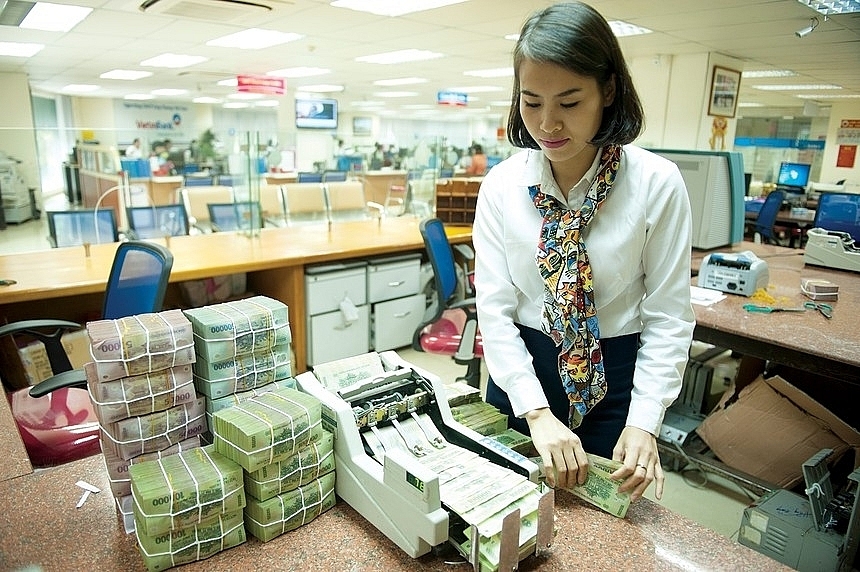 |
| If successfully implemented, the charter capital of the banking system will increase sharply in 2023. Photo: Internet |
This is expected to be a solid “buffer” providing the bank have more resources to cope with economic fluctuations and support businesses.
Accelerated capital increase plan
| According to the State Bank, by the end of 2022, the charter capital of the whole banking system reached VND 876,993 billion, up 13.04% over the same period last year. In which, the charter capital of commercial banks with state capital accounted for more than 50%, reaching VND 190,433 billion, up 5.75% over the same period; Joint-stock commercial banks had a total charter capital of VND 469,409 billion, up 19.26% over the same period in 2021. |
According to a report by the State Bank to the National Assembly, this agency has directed Vietcombank, VietinBank and BIDV to develop a plan to increase charter capital from after-tax profits, and then set aside funds in 2021 to submit to the Prime Minister for approval.
The National Assembly Standing Committee recently agreed to add to the program of laws and ordinances 2023, and submitted to the National Assembly to supplement charter capital for Agribank at the 5th session. The proposed additional capital level for Agribank for the first time is VND17,100 billion, corresponding to the remaining profit after the setting up annual funds expected to pay to the state budget in the 2021-2023 period.
Currently, in this big 4, BIDV owns the largest charter capital of 50,585 billion VND, with state capital accounting for 80.99% of charter capital. It plans to increase its charter capital to more than VND61,557 billion in 2023. VietinBank takes the second position with the current charter capital of VND48,057 billion, of which the State holds 64.46%. VietinBank’s General Meeting of Shareholders has approved the plan to increase charter capital to VND 66,030 billion. Vietcombank with a current charter capital of VND 47,325 billion, the state holds 74.8% of charter capital and it has just been approved by the State Bank to increase charter capital with an increase of about VND 27,000 billion from undistributed profits, helping to increase total capital up to about 75,000 billion VND.
Along with four state-owned banks, the State Bank of Vietnam said it had written approval to increase charter capital for 21 joint-stock commercial banks. The increase in charter capital of these banks is mainly from the bank’s equity (retained profits and reserve funds). Thus, 25 banks are eligible to increase their charter capital in the near future with the total charter capital increasing from more than 590,000 billion VND to more than 743,000 billion VND.
In which, VPBank owns the largest charter capital in the system with more than 67,430 billion VND, if the capital increase is successful, VPBank will still take the lead with a new charter capital of nearly 79,340 billion VND.
In addition, MB also plans to increase its charter capital by more than VND9,000 billion, to more than VND53,680 billion. Techcombank also plans to increase its charter capital to more than VND 35,225 billion through stock dividends or ESOP issuance. SHB plans to increase its charter capital from more than VND30,670 billion to more than VND36,190 billion. HDBank will increase its charter capital from more than VND 25,300 billion to approximately VND 29,300 billion. TPBank has approved the plan to increase charter capital from more than VND15,810 billion to VND22,016 billion. NCB will increase charter capital from VND 5,602 billion to nearly VND 11,802 billion.
Protection against market fluctuations
It can be seen that increasing capital has always been the top priority of banks in recent years. Because according to experts, high charter capital will be a “buffer” which equips banks with more resources to cope with difficulties, expands business activities, and at the same time supports the economy in general and businesses in particular.
Currently, domestic banks’ capital adequacy ratio (CAR) is still quite thin compared to regional banks, while the ratio of bad debt to total outstanding loans is on an increasing trend. According to the latest data, at the end of 2022, CAR calculated according to Circular No. 41/2016/TT-NHNN of the group of commercial banks with state capital is 9.04% and of the group of commercial banks is 12.29%. But in some Southeast Asian countries, the average CAR ranges from 17-22%. Therefore, if the state-owned banks do not raise capital in time, resources may be eroded due to competition from private banks and the implementation of support programs according to the governing body’s guidelines.
Moreover, the capital increase also helps banks to meet Basel 2 and Basel 3 standards. Dr. Daniel Borer, acting director of the Global Business Program, RMIT University (Australia), commented that the global banking industry is shaking when witnessing the collapse of banks in the US. Still, Vietnamese banks may not be at risk because they have complied with international standards. However, Dr. Daniel Borer said this is a good opportunity for banks to strengthen the financial sector further, freeing up capital flows, making Vietnam’s capital market more attractive to foreign capital.
In addition, experts also emphasized that if the risk increases, banks should focus on increasing capital and asset quality management instead of chasing profit growth. However, the plan to increase capital mainly from the issuance of more private shares must depend on the stock market movements, so the challenge of successfully raising capital for banks is not small.
